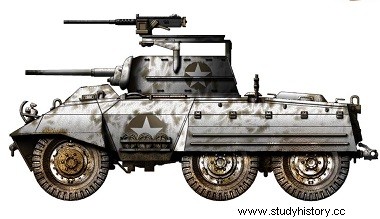
T21, T22, T23, T22E1, T22E2, M8, MW and many variants
Type :light armored car.
Crew :4 men.
Armament :a 37 mm M6 gun; a coaxial .30 M1919A4; a .50 M2 anti-aircraft machine gun on the roof of the turret.
Armour:
minimum 317 mm;
maximum 19.05mm.
Dimensions:
length :5m;
width :2.54 m;
height :2.23 m.
Weight in combat order :7.7 t
Ground pressure: 0.96 kg/cm2, at 3 inches (7.62 cm) of penetration.
Power to weight ratio :14.5 hp/t.
Engine: Hercules JXD 6 cyl. in-line water-cooled gasoline engine, developing 110 hp at 3,000 rpm.
Performance:
road speed: 88 km/h;
autonomy on the road :560 km;
vertical obstacle :0.3 m;
ford: 0.6 m;
slope: 60%.
Service time :introduced in the American army in 1943, widely used by most of the allied armies during the second world war. Post-war American military doctrine favored tracked vehicles, but the M8 remained in service in many countries.
At the end of 1941, calls for tenders were launched for a light armored car to mount the 37 mm gun. In fact the first specifications defined the vehicle as a wheeled self-propelled vehicle and the first successful bidder was a 6x4 vehicle produced by Studebaker. The original designation T43 37 mm Gun Motor Carriage became in March 1942 T21 Light Armored Car.
Some differences of opinion remained on the respective merits of 4x4 and 6x6 configurations for wheeled vehicles, decision was taken to produce two new machines, each in 4x4 and 6x6 versions, at the same time as the T21, a 6x6 . The new vehicles, designated T22 and T23 (while keeping their original designation 37 mm Gun Motor Carriage for a time) were designed primarily as tank destroyers. But even at the beginning of 1942, it was obvious that the 37 mm gun was unfit for any effective anti-tank action; the Gun Motor Charriage designation was perhaps just another ruse to secure financial or political support for the armored cars, to use the designation as an alibi — as in the case of the designation "Combat Car" before 1940. The Ford Motor Company was responsible for the 6x6 T22 and the 4x4 T22E1, while the Fargo Company was responsible for producing the T23 6x6 and the T23E 4x4.
But the drawings of the four-wheelers were very quickly thrown to the basket and the body of the T22 underwent a complete overhaul. After the increase in storage possibilities, some modifications to the gun carriage and the addition of sand shields, the T22E2 was standardized in June 1942 under the designation of M8 Light Armored Car. The hull of the M8 was made of a single piece of wrought steel whose average thickness of 19.05 mm gave its solidity to the whole. The 37 mm M6 gun was mounted in an open turret. All six wheels were assembled on spar axles, whose semi-elliptical leaf springs gave good mobility off-road. When production closed at the end of 1944, 9,253 units had left the factory.
The M8 program provided for all sorts of variants but most were never to materialize.
And, among those that emerged, only one was standardized. The version transporting troops, ammunition and supplies was designated T20, the T26 command vehicle, and T30 the machine equipped with 10 rocket launchers (178 mm) with a limited horizontal field of fire.
Finally, there is an anti-aircraft version, the T69. As it was understood very quickly that the missions of the T20 and the T26 could be carried out by a single vehicle, it was standardized under the designation of M10 Armored Utility Car. To avoid any confusion between this machine and the M10 3in Gun Motor Carriage, the designation was then changed to M20 and Ford produced a total of 3,791 examples of this vehicle of amply demonstrated utility. On the ground, the M20 showed all the qualities of a jeep which had received armor, which enabled it to fulfill all the missions previously assigned to the scout car M3.
Research on the medium armored cars continued while the M8 was still in production. Studebaker released the T27, an 8x6 vehicle. Despite good off-road performance and a road speed of 98 km/h, the T27 still had only 37 mm as its armament and represented no real progress over the M8. The studies were abandoned in July 1944. Chevrolet built a medium armored car, the T28, a 6x6.
The T28 had independent suspension on each wheel and the three axles were equidistant. Although still armed with the eternal 37 mm, the T28 was considered suitable to replace the M8 and even, subject to certain modifications, the M20; the machine was standardized in December 1944 under the designation of M38 but was not put into production due to the reduction in demand for this type of vehicle.
